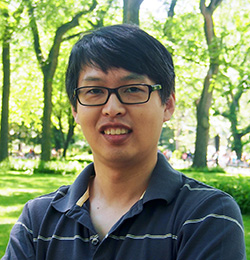Eunyong Park

Associate Professor of Biochemistry, Biophysics and Structural Biology
Lab Homepage: http://parklab.mcb.berkeley.edu/Research Interests
My group is interested in understanding molecular mechanisms of membrane proteins that mediate transport of ions and molecules across lipid bilayers. Selective and regulated transport by these channels and transporters underlies many important processes in all living cells, such as import and export of nutrients and electrolytes across cell membranes, secretion of proteins and peptides, and generation of electric signals in neurons and muscle cells.
To understand how these molecular machines work, we combine structural, biochemical, and biophysical approaches. Particularly we use cryo-electron microscopy (cryo-EM) to determine atomic structures of protein complexes.
Current Projects
The current major focus is on elucidating molecular mechanisms of channels and transporters that transport polypeptides across membranes. Many proteins move across membranes to be secreted from cells or to be imported into membrane-bound organelles such as endoplasmic reticulum (ER), peroxisomes, mitochondria, and plastids. These processes are mediated by classes of membrane protein complexes called protein-conducting channels or protein translocases. In addition, these complexes also mediate insertion of transmembrane proteins into a lipid bilayer and retro-translocation of damaged or mistargeted proteins back to the cytosol for degradation. Protein translocation poses many fundamental yet poorly understood biological questions, such as how complexes selectively recognize their substrate proteins, how they translocate large polypeptides while maintaining the membrane barrier for small molecules and ions, and how they enable directional polypeptide movement. In our lab, we would like to answer these important questions by biochemical, biophysical and structural analysis. We aim to visualize structures of these channels in various functional states by cryo-EM and reconstitute the translocation processes with purified components to dissect their operating principles. We have recently determined high-resolution structures of the Sec complex, the post-translational protein translocation machinery in the ER, and the TOM complex, the protein import channel in the mitochondrial outer membrane. We also have discovered a novel ER protein quality pathway that involves a conserved P-type ATPase. These studies provided important insights into how these complexes engage with polypeptide substrates and how their activities are regulated.
Selected Publications
Itskanov, S., Kuo, K.M., Gumbart, J.C., and †Park, E. (2021). Stepwise gating of the Sec61 protein-conducting channel by Sec63 and Sec62. Nature Structural & Molecular Biology. Jan 4, 2021.
∗McKenna, M.J., ∗Sim, S.I., Ordureau, A., Wei, L., Harper J.W., †Shao, S., and †Park, E. (2020). The endoplasmic reticulum P5A-ATPase is a transmembrane helix dislocase. Science. 369(6511):eabc5809.
Tucker, K. and Park, E. (2019). Cryo-EM structure of the mitochondrial protein-import channel TOM complex at near-atomic resolution. Nature Structural & Molecular Biology. 26:1158-1166.
Itskanov S. and Park, E. (2019). Structure of the posttranslational Sec protein-translocation channel complex from yeast. Science. 363:84-87.
Park, E. and MacKinnon, R. (2018). Structure of the CLC-1 chloride channel from Homo sapiens. Elife. 7 pii:e36629.
Park, E., Campbell E., MacKinnon R. (2017). Structure of a CLC-K chloride channel by cryo-electron microscopy. Nature. 541:500-505.
*Li, L., *Park, E., Ling, J., Ingram, J., Ploegh, H., and Rapoport, T.A. (2016). Crystal structure of a substrate-engaged SecY protein-translocation channel. Nature. 531:395-399.
Park, E., Ménétret, J.F., Gumbart, J.C., Ludtke, S.J., Li, W., Whynot, A., Rapoport, T.A., and Akey, C.W. (2014). Structure of the SecY channel during initiation of protein translocation. Nature. 506:102-106.
Park, E., and Rapoport, T.A. (2011). Preserving the membrane barrier for small molecules during bacterial protein translocation. Nature. 473:239-242.
Last Updated 2021-08-05